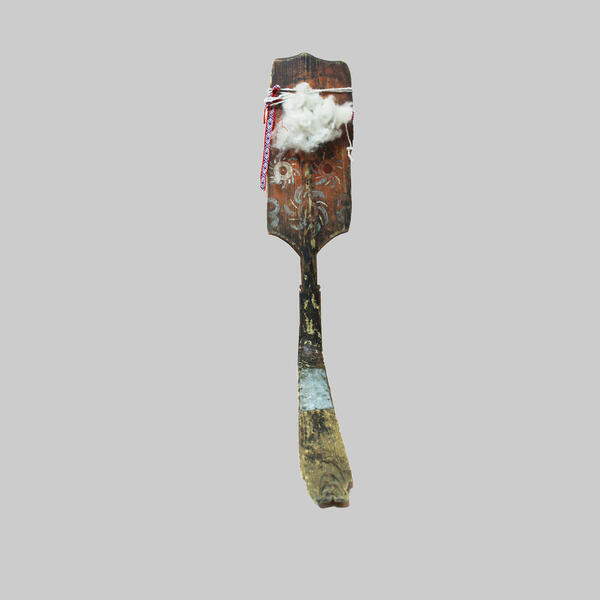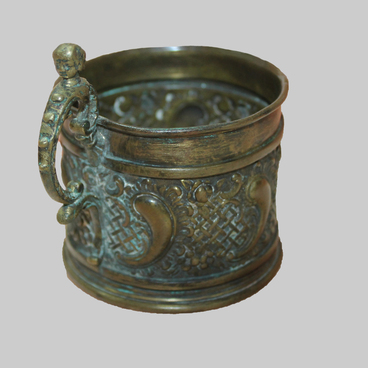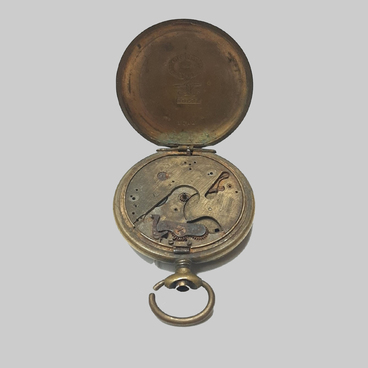A hand-spinning wheel from the museum’s collection consists of a vertical part where the tow was tied, and a horizontal bottom, on which the spinning wheel sat. The spinning wheel is carved from “kopan”, i.e. a whole tree uprooted. Such spinning wheels were called “kopyly”, or root. From the lower part of the trunk, a blade and a leg were made, and the bottom was made from the branch of the root. For the production of root spinning wheels, spruce, pine, and birch trees were usually uprooted. Their root system was suitable.
An interesting fact is that the finished spinning wheels were not used and were not considered suitable until they were decorated. In the old days, in some localities, spinning wheels were painted in the same technique as icons. The board was covered with a thin layer of chalk and glue. The original drawing was made with a thin line. Sometimes it was scratched out. The paint was diluted with egg yolk and kvass. They finished the painting with a secondary outline. To shine, the surface of the spinning wheel was covered with a special composition, which included drying oil. Later, they began to paint the spinning wheel with oil paints without a primer.
In the painting of spinning wheels, there are everyday scenes similar to popular prints, as well as elements of plant and animal ornaments. Very often, spinning wheels were decorated with ornaments of ancient symbols of the sun, stars, earth, and water elements. The image of the sun has always been perceived as a symbol that gives life-giving energy to all. The top of the presented spinning wheel is decorated with a pattern in the form of twigs of plants, while the lower part shows the heavenly bodies in the form of a flower with petals.
It is known that spinning wheels existed on the territory of our country already in the Neolithic Era. This is evidenced by the finds of archaeologists in the Vologda Region. All the women in the Russian village spun. They learned to spin from the age of 8-9 and have not parted with the spinning wheel all their lives. The girl had to strain and weave canvases for her dowry, and the woman had to dress the whole family. An old proverb says that a man does not spin, but does not go without a shirt, while a woman spins, but does not wear two shirts.
There were several spinning wheels in the house, and each woman had her own. Girls were often given spinning wheels by their grooms. Most often, the groom made a gift himself and put all his skills into making it. A woman especially cherished such spinning wheel and passed it on to her daughter by inheritance. Since the 18th century, self-spinning wheels with a wheel became widespread, which significantly accelerated the work. However, they did not displace the hand-spinning wheel. The most significant reason for this, apparently, is that women could not make fine yarn on a self-spinning machine. The best varieties of thread were spun in the old way on a spindle. Spinning wheel production continued until the 1930s. Spindles are still being sharpened in the villages.
An interesting fact is that the finished spinning wheels were not used and were not considered suitable until they were decorated. In the old days, in some localities, spinning wheels were painted in the same technique as icons. The board was covered with a thin layer of chalk and glue. The original drawing was made with a thin line. Sometimes it was scratched out. The paint was diluted with egg yolk and kvass. They finished the painting with a secondary outline. To shine, the surface of the spinning wheel was covered with a special composition, which included drying oil. Later, they began to paint the spinning wheel with oil paints without a primer.
In the painting of spinning wheels, there are everyday scenes similar to popular prints, as well as elements of plant and animal ornaments. Very often, spinning wheels were decorated with ornaments of ancient symbols of the sun, stars, earth, and water elements. The image of the sun has always been perceived as a symbol that gives life-giving energy to all. The top of the presented spinning wheel is decorated with a pattern in the form of twigs of plants, while the lower part shows the heavenly bodies in the form of a flower with petals.
It is known that spinning wheels existed on the territory of our country already in the Neolithic Era. This is evidenced by the finds of archaeologists in the Vologda Region. All the women in the Russian village spun. They learned to spin from the age of 8-9 and have not parted with the spinning wheel all their lives. The girl had to strain and weave canvases for her dowry, and the woman had to dress the whole family. An old proverb says that a man does not spin, but does not go without a shirt, while a woman spins, but does not wear two shirts.
There were several spinning wheels in the house, and each woman had her own. Girls were often given spinning wheels by their grooms. Most often, the groom made a gift himself and put all his skills into making it. A woman especially cherished such spinning wheel and passed it on to her daughter by inheritance. Since the 18th century, self-spinning wheels with a wheel became widespread, which significantly accelerated the work. However, they did not displace the hand-spinning wheel. The most significant reason for this, apparently, is that women could not make fine yarn on a self-spinning machine. The best varieties of thread were spun in the old way on a spindle. Spinning wheel production continued until the 1930s. Spindles are still being sharpened in the villages.



